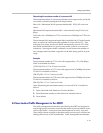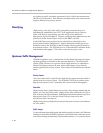
User Guide V
2
IU 4300T Converged Network Appliance
3 - 44
Although RTP makes use of UDP the 4300T appliance is able to provide its
own congestion avoidance mechanism for voice traffic using Call Admission
Control (CAC).
VoIP Survivability Configuration
The high availability of voice services is a fundamental requirement for
enterprises deploying their own IP telephony equipment or subscribing to
hosted VoIP services. In both cases providing reliable communications to
remote branch offices is costly usually involving the installation of local call
processing servers or additional wide area network (WAN) links to these
locations.
Polycom’s VoIP survivability enhances the reliability of VoIP services to
branch offices in a cost effective manner by providing local call switching in
the event of WAN link failures or a loss of connectivity to network based call
processing servers. VoIP survivability is an orderable software option for
Polycom’s V
2
IU Series appliances. V
2
IU appliances are flexible networking
devices that can also be configured to provide IP routing, optional T1 WAN
link termination, resolve NAT/firewall traversal problems, ensure high
quality voice using QoS, monitor voice call quality and provide
comprehensive security for the LAN using a VoIP and data firewall.
Key benefits and features of VoIP survivability
Polycom’s VoIP survivability offers the following important benefits:
• Continuity of voice services to branch offices during WAN link failures or
failures in network based call processing servers
• Significant savings over alternative solutions requiring redundant call
processing servers or multiple WAN links
• Simplified design that is easier to manage than alternative solutions
requiring maintenance of multiple dial plans in distributed call processing
servers and complex routing
Survivability features:
• Application layer based monitoring of call processing servers to
determine connectivity
• Automatic detection of loss of connectivity to call processing servers
caused by WAN link failures, network congestion or call processing server
software failure
• Automatic return of call control to network based call processing servers
once connectivity has been restored
• Configurable timers to determine call processing server connectivity


















